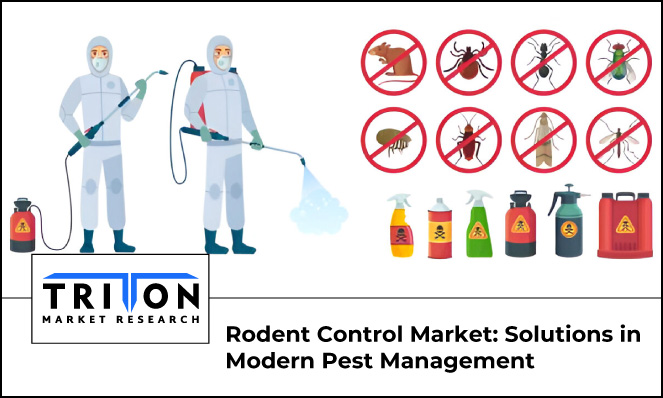



06, December 2024

As the challenge of rodent control continues, it presents critical challenges for public health, agriculture, and industrial operations worldwide. Our analysis predicts that the Global Rodent Control Market is likely to achieve revenue growth at a CAGR of 6.94% during the forecast period 2024-2032. This uptrend highlights the demand for rodent control solutions has surged, with rodent-borne illnesses being a primary catalyst. This has compelled both government and private sectors to invest heavily in pest management products and services.
Similarly, the agricultural losses attributed to rodent infestations are particularly staggering. Studies conducted by the Food and Agriculture Organization (FAO) estimate that rodents destroy approximately 20% of the world’s food crops annually. In Asia alone, rice crop losses due to rodent damage exceed $2 billion yearly, highlighting the critical need for effective agricultural rodent control pesticides.
Explore in detail about this market in our FREE sample
While the human impact of rodent infestations is staggering, the financial implications are equally compelling. Recent data indicates that companies face significant liability exposure from rodent-related health incidents. Insurance claims related to rodent-borne illnesses in commercial properties increased by 37% between 2020-2023, with average settlements reaching $175,000 per incident. This represents a crucial risk factor for facility managers and corporate risk assessment teams.
Organizations operating in rodent-affected environments face escalating healthcare expenses. Employee health claims linked to rodent exposure average 12 more sick days annually compared to standard absenteeism rates. For a mid-sized company of 500 employees, this translates to approximately $245,000 in lost productivity annually.
Connect with our experts for a simplified analysis!
In order to combat these rodent-related issues, countries worldwide have implemented comprehensive strategies for rodent management. For instance, a leading pharmaceutical manufacturer in Germany implemented an AI-powered monitoring system that reduced rodent incidents by 78% within six months.
Singapore’s integrated pest management approach stands out as a notable example. The National Environment Agency (NEA) launched an innovative digital platform in 2022 that maps rodent populations across the city-state, enabling targeted interventions and sustainable use of rodenticides.
The EU’s PiedPiper project has unveiled a groundbreaking pest control system designed to combat the growing challenge of anticoagulant-resistant ‘super rats.’ Developed in collaboration with Biotronics, this innovative solution is set to make a significant impact in the global pest control market, valued at over €20 billion.
Thus, by fostering strong partnerships between technology innovators and leading pest control companies across Europe, the project not only strengthens regional collaboration but also positions Europe as a global leader in addressing rodent resistance. This initiative opens doors to market expansion while promoting sustainable and effective rodent control solutions.
Growing awareness of the harmful impacts of chemical-based rodent control has fueled a shift toward sustainable alternatives. Arbuda Agrochemicals is leading this change with innovations like the Herbal Rat Cake, a 100% natural solution for controlling populations of rodents while safeguarding the environment. The company’s portfolio, including low-toxicity insecticides and biodegradable rat glue traps, underscores its dedication to eco-friendly pest control practices.
The SMART Cities system by Viking Pest Control utilizes the Anticimex SMART technology to provide an innovative, proactive pest management solution. This system integrates digital automation and remote monitoring with professional expertise to effectively prevent and address rodent infestations. The technology includes sensors and traps strategically placed based on a detailed site assessment. These devices continuously monitor rodent activity, relaying real-time data through a centralized control hub.
The future of rodent control lies not in viewing it as an isolated challenge but as an integral component of organizational strategy. As we continue to develop more practical approaches to managing rodent-borne illnesses and their associated risks, the path forward requires sustained investment. In this regard, the integration of artificial intelligence, predictive analytics, and biological control methods indicates a modern approach to pest control and management.
Grab a Quick Read to Get a Comprehensive Analysis of this Market
Answer: Using smoke or flooding burrows with water can be highly effective for driving rodents out in certain scenarios. Ultrasonic devices, often promoted by their manufacturers, are frequently cited as effective repellents for rats and mice in buildings.
Q.2) What are natural rodent repellents?Answer: Mice possess a highly sensitive sense of smell and are often deterred by potent odors such as cinnamon, vinegar, dryer sheets, clove oil, peppermint, tea bags, and cayenne pepper.

Prevalent cases of terrorist attacks in today’s world is increasing the need for severe standards of security for public safety, and the global market for biometric technology scrupulously accommoda..
Prevalent cases of terrorist attacks in today’s world is increasing the need for..